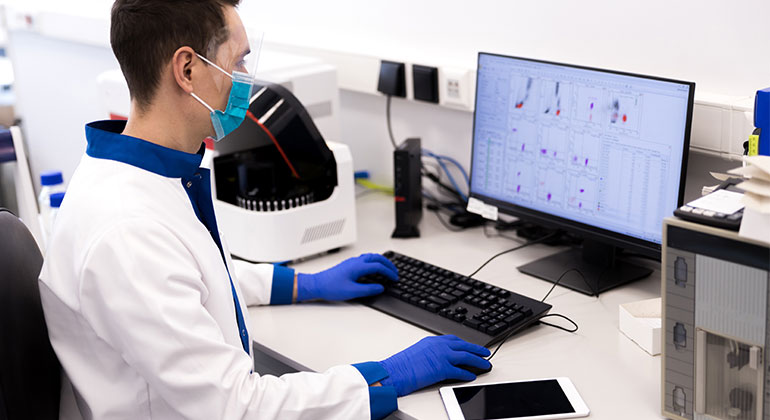Disadvantaged Neighborhoods See More COVID-19 Infections and Deaths, Mount Sinai Scientists Report
Neighborhood-level COVID-19 inequality index created to analyze disparities

New York City neighborhoods that had higher levels of socioeconomic disadvantage experienced more COVID-19 infections and deaths, according to Mount Sinai scientists who created a neighborhood-level COVID-19 inequity index.
The index measured factors that fueled inequities in the residents’ lives, such as employment and commuting patterns, population density of their neighborhood, food access, socioeconomic status, and access to health care. This allowed the scientists to compare between neighborhoods the contributions of these social factors in facilitating disease transmission during the first wave of the pandemic in a study published in Nature Communications in June.
“Much of the early rhetoric around COVID-19 disparities centered on comorbidities which, due to health disparities, may have explained why communities of color were suffering higher mortality. But we were seeing more people of color getting infected in the first place,” said Daniel Carrión, PhD, MPH, first author and postdoctoral researcher in the Department of Environmental Medicine and Public Health at the Icahn School of Medicine at Mount Sinai. “Our research team wanted to add to the literature outlining how structural racism is related to neighborhood disadvantage, and how that disadvantage is related to increased COVID-19 infections and mortality.”
The COVID-19 inequity index showed that the disparities were considerably worse based on neighborhood racial and ethnic composition; Black neighborhoods had the highest average inequity index, followed by Latinx communities, while white neighborhoods had the lowest. The authors believe one of the reasons for these disparities is the diminished capacity to socially isolate based on where someone lives.
This study showed that areas with higher COVID-19 inequity indices had higher subway ridership after New York State introduced stay-at-home orders. This implies that the residents had less capacity to socially distance, the researchers said, possibly due to their jobs as essential workers or because they lived in denser housing.
The researchers believe their approach to identifying social factors that are associated with viral spread may be useful throughout the United States to pinpoint potential areas for targeted public health intervention.
“The social factors in the COVID-19 inequity index are upstream neighborhood characteristics—they were already in place before the pandemic,” said Allan Just, PhD, senior author on the study and Assistant Professor of Environmental Medicine and Public Health at Icahn Mount Sinai. “In the near term, this speaks to the importance of place-based interventions in Black, Indigenous, and people of color (BIPOC) communities to reduce disease incidence and mortality, such as improved and targeted vaccine availability for these communities. This also supports the need to look at social factors in pandemic preparedness.”
The team analyzed many forms of publicly available data, including census, New York City subway ridership, New York City Department of Health and Mental Hygiene infections and mortality data, and other datasets available through New York City’s and New York State’s open data portals.
Many neighborhood-level social variables are closely related; for example, median income can be strongly associated with education or even food access. This can be a challenge for traditional statistical approaches, so the team employed a new statistical framework designed to deal with these challenges, developed by co-author Elena Colicino, PhD, Assistant Professor of Environmental Medicine and Public Health at Icahn Mount Sinai.
The COVID-19 inequity index included neighborhood-level characteristics, but specifically excluded race and ethnicity as input variables. “Past literature shows that structural racism operates by historically sorting BIPOC people into neighborhoods that do not have the same resources and may facilitate infectious disease transmission,” said Dr. Carrión. “We wanted to see if our index reconstructed those racial disparities.”
The research was supported by funding from the National Institutes of Health grants UL1TR001433, P30ES023515, and T32HD049311.
Additional authors include Nicolo Foppa Pedretti, MS, Kodi B. Arfer, PhD, Johnathan Rush, MA, and Nicholas DeFelice, PhD, in the Department of Environmental Medicine and Public Health at Icahn School Mount Sinai.
About the Mount Sinai Health System
Mount Sinai Health System is one of the largest academic medical systems in the New York metro area, with 48,000 employees working across seven hospitals, more than 400 outpatient practices, more than 600 research and clinical labs, a school of nursing, and a leading school of medicine and graduate education. Mount Sinai advances health for all people, everywhere, by taking on the most complex health care challenges of our time—discovering and applying new scientific learning and knowledge; developing safer, more effective treatments; educating the next generation of medical leaders and innovators; and supporting local communities by delivering high-quality care to all who need it.
Through the integration of its hospitals, labs, and schools, Mount Sinai offers comprehensive health care solutions from birth through geriatrics, leveraging innovative approaches such as artificial intelligence and informatics while keeping patients’ medical and emotional needs at the center of all treatment. The Health System includes approximately 9,000 primary and specialty care physicians and 10 free-standing joint-venture centers throughout the five boroughs of New York City, Westchester, Long Island, and Florida. Hospitals within the System are consistently ranked by Newsweek’s® “The World’s Best Smart Hospitals, Best in State Hospitals, World Best Hospitals and Best Specialty Hospitals” and by U.S. News & World Report's® “Best Hospitals” and “Best Children’s Hospitals.” The Mount Sinai Hospital is on the U.S. News & World Report® “Best Hospitals” Honor Roll for 2025-2026.
For more information, visit https://www.mountsinai.org or find Mount Sinai on Facebook, Instagram, LinkedIn, X, and YouTube.
Mount Sinai Researchers Find Significant Delays in West Nile Virus Reporting
Apr 26, 2019 View All Press Releases